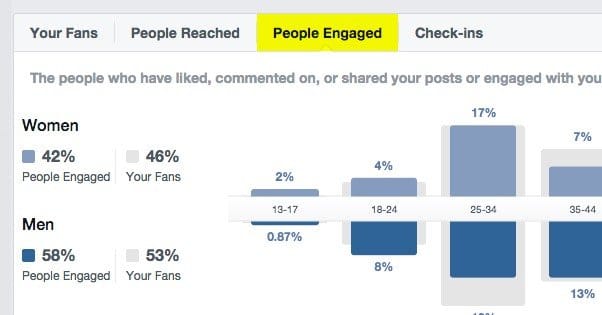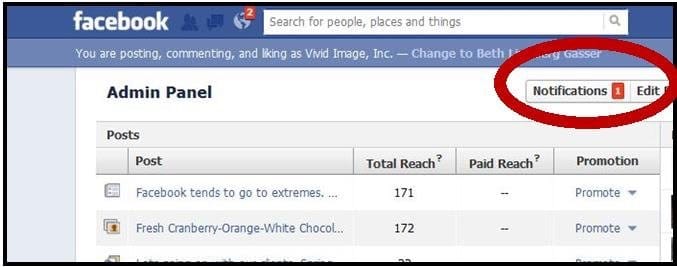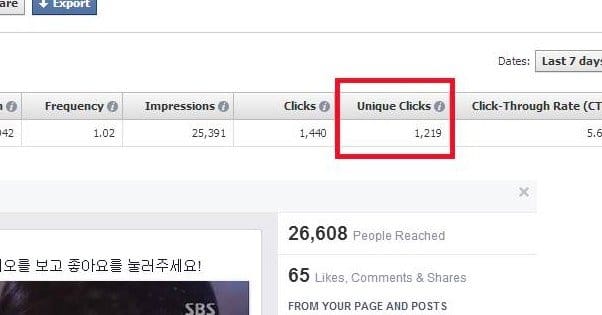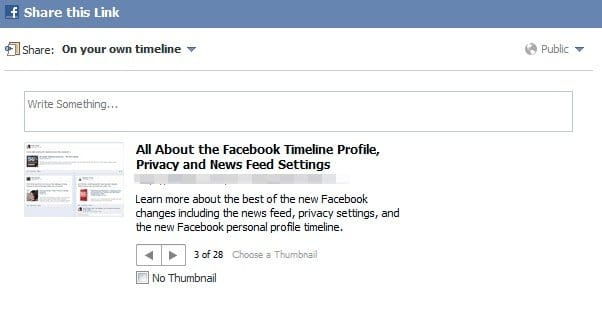 Written by ContentPowered.com
Written by ContentPowered.com
The “people engaged” metric on Facebook is actually a surprisingly important metric, because it’s sort of a one-stop indicator of the success of your posts. It’s not very granular – that is, it doesn’t give you a lot of specific information – but it’s still a good growth point. If you’re seeing your people engaged number rising from month to month, you can be sure that you’re growing, though you’ll have to dig a little deeper to determine exactly where that growth is coming from or how valuable it is.
To learn how to increase your people engaged number, you need to know what goes into it. As you learn that, you’ll also learn why it’s such an imprecise number.
The Components of People Engaged
People engaged is an aggregate number. It’s not a number that relates to others, it’s not a percentage, and it’s not an algorithm. It’s a simple counter that goes up based on certain forms of engagement going up.
The component parts of the people engaged calculation are:
- Post link clicks.
- Post likes.
- Post comments.
- Post shares.
There are two limits on the number. One is duration; it only calculates the last 7 days worth of people engaging with your page in some way. The other is uniqueness. People engaged only counts the number of unique people performing these actions.
For example, say you made one single post in the last seven days. This isn’t a good idea – you should post more often – but it makes the example simpler. On that post, 200 people click the link you posted. 100 of those people like that link. The post receives 35 comments, and 10 shares. For the sake of simplicity, we’ll say that no single user clicked more than once, or commented more than once.
With these numbers added up, your people engaged number will be 345.
If you consider a more realistic scenario with multiple posts and users who click and comment more than once, your actual monitored numbers and your people engaged will be different. For example, if a post receives 50 comments, but it’s largely three people going back and forth with a discussion, that will only count for 3 in the people engaged score, even though your insights will say you received 50 comments.
Now, the reason I call people engaged an imprecise monitor is because of this duplication, as well as the different component parts. You could have a people engaged score of 250, and if 200 of those are likes, that’s not really that valuable. However, if 200 of them are link clicks, or are post shares, you have a more valuable situation. This is because likes, on their own, don’t do much for you. Shares are better, because they increase your viral reach. Comments are good for EdgeRank purposes, and to spur other users into discussion. Link clicks are arguably the best, because that’s how you funnel users to your site, where you can expose them to other forms of advertising and urge them to convert.
That’s not to say it’s a bad number. It’s actually very potentially useful. Jon Loomer suggests using it as part of a calculation to monitor how engaged your audience as a whole is. Take your people engaged and divide it by your total page likes. This will show you what percentage of your audience is engaging with your page on a regular basis. When this number goes up, so too does the popularity and success of your page.
You can also use your people engaged score and compare it to your post reach. It’s better to have a higher percentage here; you want as many of the people who see your post to engage as possible. Jon Loomer’s calculations take the lifetime numbers rather than the weekly people engaged number, however.
Drawing a Distinction: PTAT
Another metric on Facebook that most people like to measure is called People Talking About This. Often called PTAT, it’s a metric very similar to people engaged, it just includes more. It is also measured in terms of unique visitors, and it’s also a 7-day metric, although you can see it historically or an overall number in your insights. So what is included in PTAT?
- Page likes, or follows.
- Post shares, likes, or comments.
- Question answers and event responses.
- Page mentions on non-page posts.
- Page tags on photos.
- Check ins and recommendations in the review system.
- Offer claims.
Essentially, it’s a measure of pretty much any action a user can take regarding your page on Facebook, short of an unfollow. It doesn’t count implied mentions, or posts that mention you without actually linking to your page. It also doesn’t count link clicks or anything to do with ads, unless those ads lead to engagement or follows.
Now, how about growing your people engaged number? Now that you know what goes into it, you know how to improve it. Just improve each of the component parts. Remember; it only counts unique people engaging, so getting one person to comment 10 times won’t improve your score. You need to get more people engaged.
General: Growing Your Audience
No matter what, the best way to increase your people engaged score is to increase your audience in general. Consider the statistics from PostPlanner. On a fan page with between 10,000 and 100,000 fans, the average number of interactions per post was around 118. Even fan pages with over 10 million fans only received about 26,000 interactions, of which plenty are sure to be duplicates and thus not counted under people engaged.
You can use those statistics to see how your fan page measures up. There’s nothing more granular, though, so most small businesses will just forever linker in the sub-1,000 category or the 1,000 to 10,000. Some will grow to the 10,000-100,000, but it takes a lot of growth and an established business to make it about 100,000. That, or a lot of money invested in buying legitimate followers.
Anyways, the point I’m trying to make is that to a certain extent, your people engaged number is a percentage of your users. As long as the average engagement level of your users stays the same, as you grow your audience, so too will your people engaged grow. If you have a people engaged ratio of 10%, when you have 1,000 followers you will have a PE of 100. If you grow to 2,000 followers, at a 10% engagement rate, you’ll have a PE of 200. It’s simple math.
Now, this means that you have to strive to keep your engagement levels the same, or better, as you grow. It doesn’t make sense to buy 1,000 fake fans. It would increase your followers to 2,000, but drop your engaged ratio to 5%, so your PE remains at 100.
If you want to grow your PE by increasing your number of followers, you’ll need to make sure you’re getting legitimate fans. You want fans that are as engaged as possible, which means you need to study your demographics, particularly the demographics of your most engaged users. You’re always going to accumulate some fake followers, and thankfully at a low level, it’s easy to find and remove them. I highly recommend you keep on top of it now, because it becomes nearly impossible once you have more than a few thousand followers. There’s no way to scan through them all.
How can you grow your page? The number one method is activity, and it’s also going to help your PE score because you’ll have more posts that, ideally, appeal to more people to attract more unique users. If you post three times per week, up it to five. If you post five times per week, up it to seven. If you post seven times per week, double up on some days. Increase your activity levels until you’re at minimum in line with the average for successful pages. You can find those statistics online; they change every few months.
Of course, while you’re posting more, you also need to be maintaining a certain level of quality. You can’t just throw up boring meme posts, old content, and bland text posts with the expectation that any activity is better than no activity.
There’s also always Facebook ads. Those are a whole topic on their own, but they’re an excellent method to use to grow your audience. Just remember that you need to target them appropriately if you want any chance of success. Good targeting and testing your content; that’s all you need. Run ads with the page likes objective to grow your audience, target them at a lookalike audience that shares demographics with your own, and you’re well on your way to basic targeted advertising. Bear in mind, when budgeting, that it costs anywhere from 20 cents to $1 per gained follower, so plan accordingly.
Improving Link Clicks
If you want more people to click the links in your posts, you need to optimize your posts for that purpose. Here are a bunch of general tips. The number one tip, though, is to always include a link whenever possible.
Yes, I know that images and videos have their role, as do text posts. I’ll cover those in other parts of this guide. It’s just sensible for this section that, if you want more link clicks, you need more links.
Links on Facebook generate a preview when you plug in a URL, so use that to your advantage. The first thing you should do is remove the URL so the text post you make isn’t cluttered with a secondary link. The second thing you should do is customize the preview.
There are two ways you can customize the preview; through your site and through Facebook. On your site, you can use the open graph meta elements to specify the image, title, and description you want the link to generate when it’s put into Facebook. Do this! Every post you make on your site should have these attributes customized, so that whenever anyone shares your link without sharing the post you made, it shows up the way you want it.
If you want to customize the post in a different direction, for testing, you can do that on Facebook. Before you submit the link, you can edit the title, description, and image. The ideal way to use this is to use post targeting – guide here – to post the same link twice, to two different segments of your audience. Customize the link for each and see which performs better.
Of course, it also helps to make sure that the content you post on your website and subsequently link to is of the highest quality and most interesting possible subjects. This is an ongoing battle we all have to face as marketers, and it’s not one with an easy solution. Just get to know your customers, learn what they like and need, and give it to them as best you can. That’s all any of us can do.
Improving Post Likes
Improving likes is in many ways the same as improving link clicks, but there are a few other techniques you can use as well. For one thing, it works for non-link content, like videos and images. That’s what I suggest you focus on; visual media performs much better on Facebook than just about any other kind of media. The only reason you shouldn’t use images for everything is because you’ll never get referrals to your website if you don’t share your website content.
Here are some guidelines for posting and sharing images on Facebook. You can apply many of them to video as well, though you should also read some guides to optimizing Facebook videos.
- Avoid violating copyright by using an image that isn’t yours to use. If you’re using Google to find images to use, click the “usage rights” drop-down and specify “creative commons” to make sure you’re free to use the images you find there.
- When possible, post graphics you make yourself, to minimize the “I’ve already seen that, yawn” reaction from your audience. Infographics can work especially well.
- Feel free to take photos and post them, though it’s generally better to post a bunch in one album all at once than it is to stagger out a dozen pictures of the same event over the course of weeks.
- Avoid cluttering up your images with too much text, though occasionally motivational texts or text memes are valuable for engagement.
- Consider posting fill-in-the-blank images to encourage engagement. This will work best for increasing comments, but it increases likes as well.
- Feel free to go “off topic” by posting about stuff that isn’t 100% relevant or reliant on your brand. Your users are perfectly fine with you asking them what their favorite band is, rather than asking them what their favorite product out of your catalog is. Though, those sorts of questions can work too, particularly for brands like Yankee Candle, which has thousands of scents to pick through.
- Run contests that “require” a like to enter. You can’t like-gate contests these days, but you can make likes, comments, and shares all entry methods for your contest. Tell users via an image that as they like it, share it, and comment on it, they gain entries. At the end, you’ll pick a name at random.
As a note about contests, always make sure to give away something relevant to your business. It’s okay to go off-topic for questions and surveys, but if you’re giving away something more generally desired, like a video game console, a lot of people will enter when they don’t care about anything but the prize. That’s no way to build up your people engaged; it just boosts it for a week and drops it when the contest is over.
The content users share on Facebook falls into one of a few categories.
- Short, bite-sized chunks of content that have broad appeal.
- Memes that have humor and are broadly relatable.
- Emotional content that brings a bit of positive – or negative – energy to the news feed.
- Useful content that the friends of the reader would be interested to see.
Therefore, to increase shares, make sure your content falls into one of these categories.
All content you want to be widely shared should be brief. I don’t necessarily mean brief in length, though. I’ve seen relatively long stories and jokes told time and again, like the sort of thing you’d get from your grandma in your email inbox with eight FWDs in the subject line. I’m talking narrative abbreviation; it doesn’t take a lot of prior knowledge or a lot of cognitive investment to follow to the conclusion. The less effort it takes to extract value from the post, the more likely it will be to be shared.
Memes can be very viral, or they can absolutely fall flat. I recommend avoiding using them unless you’re very, very on top of them. I’m talking “avid user of Tumblr, Reddit, and Imgur in your spare time” on top of them. The life cycle of a meme can be measured in hours, and if you’re trying to use it beyond its peak, it might look pathetic, or it might just look absurd. That said, some memes can be very good for your brand. I tend to prefer more generalized memes, rather than industry-specific memes that look like an out of touch focus-grouped “teen culture” outreach. Also, always make sure you understand the connotations of a meme. Confession Bear might seem like a good meme to subvert by “confessing” something that humanizes your brand in a positive way, but it’s almost always used to tell horrible fake stories and thus isn’t a good thing to associate with your brand.
Emotional content is always good, in contrast. It can be anything from adorable pictures of baby animals to the Sarah McLaughlin humane society style heartstring tugging. You can also use emotion to newsjack, though you have to be very careful to be on the positive side of an issue. There’s a lot of social turmoil in the world today, and if you position yourself on the right side of the issue, you can come out very much ahead. See: the recent Target announcement of de-segregating their kids toys. On the other hand, you can take the wrong side and end up losing business, like many of the small businesses that have been overrun with negative criticism when they promote overt racism.
Useful content is probably the best content to earn shares with, primarily because it’s not emotionally manipulative. It’s genuine value, and it’s shared because of that value. That means it will often earn many more shares over a longer period of time than memes or humor, but it also means you have to put a lot more work into creating the content in the first place.
Improving Post Comments
There’s not a lot I can say about getting more comments that isn’t already said in one of the previous sections. There’s just one thing you need to keep in mind to earn more comments, and that’s “social media is a two-way street.”
Every communication you make, every post, is the opening of a conversation. Treat it as such. Give users a way to comment, an opening to continue the conversation. Ask a question, solicit feedback. More importantly, when users give that feedback, respond. Continue the conversation.
Yes, multiple comments from one user won’t count when it comes to people engaged. That’s fine. The point is to get them to comment consistently, so that they comment on multiple posts over multiple days or weeks. It also encourages other people to comment, when they see lively discussions to which they can respond.
Keep all of this in mind and you’ll be able to growth both your people engaged number and your audience in general. From there, well, you just have to figure out what to do with all of those users!



